 image by Eugene Ipavec, 5 February 2006
image by Eugene Ipavec, 5 February 2006
FOTW beschäftigt sich mit der Wissenschaft der Vexillologie (Flaggenkunde).
Alle auf dieser Website dargebotenen Abbildungen dienen ausschließlich der Informationsvermittlung im Sinne der Flaggenkunde.
Wir distanziert uns ausdrücklich von allen hierauf dargestellten Symbolen verfassungsfeindlicher Organisationen.
Last modified: 2021-01-16 by rob raeside
Keywords: colombia | intelegence | bicol | mfo |
Links: FOTW homepage |
search |
disclaimer and copyright |
write us |
mirrors
See also:
Yesterday,
RCN
news channel announced the changes in the military hierarchy
of Colombia. Among these new postings, they mentioned the new
appointment of a General in the position of Commander of a new
Joint Command. The new unit will be named Comando Conjunto No. 2
'Pacífico' (Joint Command No. 2 'Pacific') and the flag will
have the same pattern as the Joint Command No. 1
'Caribbean'.
Also the creation of a new Army Division, the Octava División
(8th Division). The 8th Division War Flag follows the same
pattern as all of the other Army Divisions and the Standard is
the plain red flag plus the Coat of Arms which is still unknown.
I found an article on local newspaper
El
Colombiano where they mention the composition of the Comando
Conjunto No. 2
'Pacífico'. The units are: Army's Third Division, the FNP
(Fuerza Naval del Pacífico, Navy Pacific Force) and the CACOM
No. 3 (Comando Aéreo de Combate No. 3, Air Combat Command No. 3)
of the Air Force.
E.R., 13 November 2009
 image by Eugene Ipavec, 5 February 2006
image by Eugene Ipavec, 5 February 2006
There's a military Task Force in Colombia recently created
which is higher than an Army Division (in the Military
hierarchy). It is only a temporary task force, but it comprises a
lot of military manpower, so it is very important. The official
name is Comando Conjunto No. 1 'Caribe' (Joint Command No. 1
'Caribbean'), and it comprises the Army's First Division, and the
Navy's First Marine Infantry Brigade, plus some other smaller
units.The flag is the Colombian tricolor, plus the Coat of Arms
of the General Forces Military Command. The image looks pretty
similar to the alternate version of the General Forces Military
Command, only that the lettering changes a bit: on the top it
reads COMANDO CONJUNTO, and on the bottom reads NUMERO 1 CARIBE.
E.R., 5 February 2006
There's a very thorough
article
that appeared on Revista Aeronáutica (official Colombian Air
Force Magazine), Edition 254, Year 2008, Volume II, with the
explanation of the organization and operation,a s well as the
chain of command of a Comando Conjunto (Joint Command) o Fuerza
de Tarea Conjunta (Joint Task Force). The organizational chart is
here.
E.R., 31 August 2009
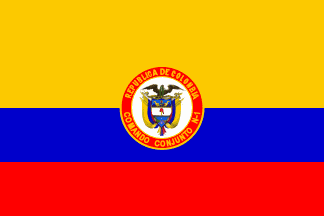 image by Eugene Ipavec, 05 July 2011
image by Eugene Ipavec, 05 July 2011
 image by Eugene Ipavec, 05 July 2011
image by Eugene Ipavec, 05 July 2011
There are two additional flags of the The Joint Command No. 1 'Caribbean'. In
this
image one can see on the left the Standard of the JC1 (Colombian tricolor
flag, on top reading REPUBLICA DE COLOMBIA in golden capital letters around the
CoA and on the bottom reading COMANDO CONJUNTO No1 in golden capital letters as
well), and on the right side of the picture is the War Flag (variant) of the
already reported image. The variant is the
General Command of Military Forces Flag (variant)
but instead of reading COMANDO GENERAL on top, it reads COMANDO CONJUNTO No1 in
golden capital letters.
Esteban Rivera, 11 September 2010
In addition to the Joint Command No. 1 'Caribbean', I should mention
the full list of Task Forces up to date:
Joint Task Forces (combine Army, Navy and Air Force elements):
- Nudo de Paramillo (not featured on FOTW) based in Nudo de Paramillo, border
between Córdoba and Antioquia
- Sur del Tolima
- Quirón based in Arauca
- Apolo based in Cauca
- Omega based in Meta
- Vulcano based in Catatumbo region of Norte de Santander
- Pegaso based in Nariño
Other Tasks Forces (single-Force elements only):
- Ares (Air Force Task Force) based in Vichada
- Poseydon (Navy Task Force) multiple-based in Riverine harbours nationwide
Source:
http://www.semana.com/photos/1561/ImgArticulo_T2_108407_2012331_163935.jpg
(Semana magazine article published on April 1, 2012)
Esteban Rivera, 25 April 2012
 image located by Esteban Rivera, 17 July 2013
image located by Esteban Rivera, 17 July 2013
Following the same pattern as the Joint Command No. 1 'Caribbean'
flag, this time the Comando Conjunto No. 2 "Suroccidente"
(Joint Command No. 2 'Southwest') has the same flag colors, and around the Coat
of Arms
it features on top the letters "CCON No.2" (CCON being the abbreviation Comando
Conjunto) in golden letters and on the bottom the letters "SUROCCIDENTE"
(Southwest).
Image is a screenshot taken today from RCN news channel broadcast)
Esteban Rivera, 17 July 2013
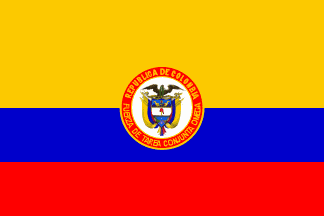 image by Eugene Ipavec, 11 August 2009
image by Eugene Ipavec, 11 August 2009
I've spotted the flag of the Fuerza de Tarea Conjunta Omega
(Omega Joint Task Force). It is displayed today on the General
Command of the Military Forces
official
website.
A Joint Task Force is by definition a military formation composed
by elements assigned to it two or more Forces (i.e. Army, Navy,
etc,) created by the Minister of Defense, or the Commander of a
Unified or Specific Command or by the Commander of an already
existing Task Force. It has very specific missions and goals and
the unit is disbanded once those objectives are accomplished.
Source:
www.cgfm.mil.co.
Colombia has had several Comandos Especificos (Specific Commands)
specially regarding the expansion of the Air Force (Air Bases
were used first as Specific Commands). Also the Army usually
prior to the establishment of a Brigade or Division has a Unified
Command for this purpose.
E.R., 10 August 2009
The motto (or at least some writing, it looks longer than just
the motto) should go in the black border of the shield.
Eugene Ipavec, 11 August 2009
The Fuerza de Tarea Conjunta “OMEGA” (Joint Task
Force "OMEGA") has been activated with Command Post in
Larandia, which belongs to the Municpality of Florencia in the
Department of Caquetá.
This Task Force has some 15,000 troops, combining Army, Navy and
Air Force elements as follows:
Field units of the Task Force consist of eight brigades as
follows
- Mobile Brigades 1, 2 and 3 which make up the FUDRA (Fuerza de
Despliegue Rápido, Rapid Deployment Force), these units are based
in La Macarena in the Department of Meta
- Mobile Brigade No. 6 based in Cartagena del Chairá, Department
of Caquetá
- Mobile Brigade No. 7 based in Calamar, Department of Guaviare
- Mobile Brigade No. 9 based in San Vicente del Caguán,
Department of Caquetá
- Mobile Brigade No. 10 based in Miraflores, Department of
Guaviare
- Mobile Brigade No. 22 based in Pe?as Coloradas, Department of
Caqueta.
Apart from the land component, the JTF has a river component
located in Tres Esquinas, Department of Caqueta, and an aviation
component in the bases of Larandia and Apiay.
Sources: www.armada.mil.co,
Wikipedia.
E.R., 31 August 2009
Some of the Units of the Omega Task Force are seen in this
image. (Source: Comando General de las Fuerzas Militares official
website, picture taken on April 24, 2012)
In the picture, one can see from left to right the following flags:
- Republic of Colombia
- Comando Específico del Caguán Standard (this is the Unit's HQ Command) (the
flag has inside its coat of arms in the middle, composed of the map of the
Caquetá Department, with a silver sword in the middle
and on top the Greek letter Omega in capitals), with a red circle around it that
reads COMANDO ESPECÍFICO DEL CAGUÁN (Caguan's Specific Command) on top, and FE
EN LA CAUSA (faith in the cause) on the bottom, both in black.
Caguán is a Municipality (full name San Vicente del
Caguán) and it was the main location where the failed peace negotiations
between the Farc guerrilla and the government took place (1999-2002), during a
Demilitarized Zone established by the government for that purpose only , known
officially as the Zona de Distensión (Distension zone), but informally known as
"El Caguán" (The Caguan) (Source:
http://en.wikipedia.org/wiki/El_Caguan_DMZ ).
- Two flags of undetermined Mobile Brigades
- Brigada Móvile No. 22 (Mobile Brigade No. 22) (the flag is a red horizontal
flag, with the coat of arms in the middle, the coat of arms being a green
background with two golden fringes around it, and in the middle, a helicopter
with one wing on each side and a sword in the middle), like the following
images:
http://www.septimadivision.mil.co/tools/microsThumb.php?src=recursos_user/imagenes//div7/escudo_Brim_25.jpg&w=335
(Source:
http://www.septimadivision.mil.co/?idcategoria=239517 ) and
http://www.ejercito.mil.co/tools/microsThumb.php?src=recursos_user/imagenes//AENE2010/el_tiempo/BRIGADA_MOVIL_5.jpg&w=321
(Source:
http://www.octavadivision.mil.co/index.php?idcategoria=6 )
Esteban Rivera, 01 May 2012
On April 19, a new Task Force was set up. The Fuerza de Tarea del Sur
del Tolima (South Tolima Task Force) was set up, basically with the
sole purpose of capturing or neutralizing the Farc's Top Commander.
It is composed of its HQ based in Chaparral, the Brigada Móvil 8
(Mobile Brigade No. 8) , the Brigada Móvil 20 (Mobile Brigade No. 20),
the Batallón de Alta Montaña ‘General Santos Gutiérrez Prieto’ (High
Mountain Battalion No. 3 ‘General Santos Gutierrez Prieto’), one
Company of the Batallón Plan Especial Energético y Vial 6 (PEEV
Battalion No. 6), a Detachment of Tiradores de Alta Precisión (High
Precision Shooters), and a Company of a Batallón de Apoyo de Servicios
Para el Combate(ASPC Battalion).
Its Area of Operations are the follwing Municipalities:
Río Blanco, Planadas on the Department of
Tolima, Pradera and
Florida on the Department of Valle, also on
Miranda, Corinto,
Toribio, Páez and Belalcazar on the
Department of Cauca.
Sources:
http://www.ejercito.mil.co/?idcategoria=243929
http://www.mindefensa.gov.co/index.php?page=181&id=10528&PHPSESSID=35db37ef9e1815dd6a6771c8f2090f21
http://www.cgfm.mil.co/CGFMPortal/index.jsp?option=noticiaDisplay&idNoti=3318
The Unit's Pennant uses the same template as the General commanding a Unit (reverse is
the tricolor Pennant with the General Star rank symbol, and the
obverse is the same image as the BRIAV Pennant, the only difference
being the initials FTST, that stand for Fuerza de Tarea del Sur del
Tolima (South Tolima Task Force) on bold capital golden letters as
well).
Esteban Rivera, 21 April 2010
 image by Eugene Ipavec, 16 September 2009
image by Eugene Ipavec, 16 September 2009
Unit Flag
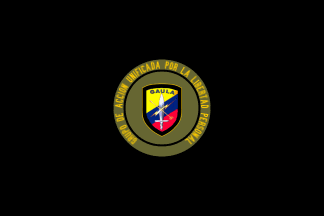 image by Eugene Ipavec, 25 September 2009
image by Eugene Ipavec, 25 September 2009
Unit Flag - variant
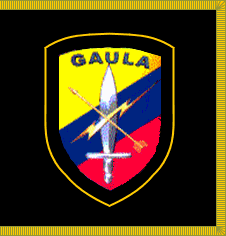 image by Eugene Ipavec, 11 August 2009
image by Eugene Ipavec, 11 August 2009
Commander Pennant
The GAULA (Grupo de Acción Unificada por la Libertad Personal,
Unified Action Group for Personal Liberty) are units set up
against kidnapping and extorsion. The GAULA were formerly known
as UNASE (Unidad Anti Extorsión y Secuestro, Anti Extorsion and
Kidnapping Unit) units.
The GAULA units were created by Law 282 of June 6, 1996
effectively replacing the UNASE units. There are GAULA units in
the Police acting autonomously, that is, being independent in all
stages of fighting urban crime (intelligence, logistics, combat,
etc.). However the Military GAULA units (Army, Navy and Air
Force) have to act with an ad hoc attorney, usually a member of
the DAS or the Fiscalía, because the Military Forces
don't have judicial capacity to legalize captures and other
proceedings, so they always have to act with an embedded judicial
police. These units depend in administrative terms from the
Ministry of Defense ) but operationally speaking work inside the
Army and Navy Brigades where they are fisically located according
to the organizational chart
here.
The Police GAULA units are under the DIASE (Dirección
Antisecuestro y Extorsión, Antiextorsion and Anti-kidnapping
Directorate). Official website at
oasportal.policia.gov.co.
The Army GAULA units are under the DIASE (Dirección Antisecuestro
y Extorsión, Antiextorsion and Anti-kidnapping Directorate).
Official website at www.ejercito.mil.co.
There are a total of 34 GAULA units, 15 Urban GAULA units under
the Police command and 19 Rural GAULA units 17 under the Army and
2 under the Navy. Sources:
www.fondelibertad.gov.co,
www.specialoperations.com
and Wikipedia.
The Pennant of the Commander of the Army GAULA units is seen
here
(Picture taken on July 20, 2008). It is a black square, with a
yellow bordering featuring the GAULA Coat of Arms in the middle.
The GAULA Coat of Arms can be found
here.
The motto reads in Latin: DE OPPRESSO LIBER (Freedom to the
oppressed, the actual same motto of the U.S. Army Special
Forces).
E.R., 10 August 2009
On this
www.mindefensa.gov.co
by the Ministry of Defense one can see on the right side the flag
of GAULA (Grupos de Acción Unificada por la Libertad).
GAULA is an acronym for Unificada Grupos de Acción por la
Libertad Personal, ie Unified Action Groups for Personal Liberty,
specialising in solving hostage-taking. These are elite units
established in 1996 exclusively dedicated to the combating of
kidnapping and extortion. They are composed of highly qualified
personnel who conduct hostage rescues and dismantling of criminal
gangs at the root of crimes which compromise the personal freedom
of Colombians. There is an inter-institutional element in GAULA
guaranteeing self-checking procedures, trained by staff of the Administrative Security Department, the
Technical Investigation Corps (CTI) of the Criminal Investigation Bureau and
military forces. Currently, the country has 16 GAULA of the
Colombian National Army and 2 of the Navy.
Sources:
Wikipedia, www.ejercito.mil.co,
www.cgfm.mil.co.
The GAULA groups are funded directly by the government and the
entity that administrates its funds is FONDELIBERTAD, Fondo
Nacional para la Defensa de la Libertad Personal (National Fund
for the Defense of Personal Freedom). FONDELIBERTAD depends
directly on the Ministry of Defense. FONDELIBERTAD was created by
Decree No.
1723 of October 6, 1995 and the GAULA were created by
Law
282 of 1996. For the full legal background and evolution see
www.antisecuestro.gov.co.
For the full list of GAULA units (military and Police combined)
see here.
Prior to the existence of the GAULA, there were the UNASE (nidad
Antisecuestro y Extorsi?n, Anti-Kidnapping and Extortion Unit).
UNASE units were created in response to a record number of
kidnappings in Bogota in 1991. Not a counterterrorist force in
the true sense, the specialty of UNASE is hostage rescue.
Nonetheless, as guerrilla groups such as FARC and ELN are
frequently the perpetrators of kidnappings-for-ransom, UNASE
teams often find themselves involved in firefights with these
terrorists. Like many other hostage rescue/CT teams, UNASE
volunteers come from the ranks of the police force, not the
military.
Each unit is made up of 35 men, five officers and 15 NCOs and 15
special agents. UNASE worked with the British SAS to effect the
rescue of Staff Sergeant Timothy Cowley in 1995. has effected
dozens of successful rescues. Some members of UNASE were trained
in Madrid under the Spanish Civil Guard. These units are now
based in most major Colombian cities including Cali, Bogota,
Barranquilla and Bucaramangara.
Source:
www.specialoperations.com.
The flag of the military GAULA units is a camouflage horizontal
flag with the logo in the middle.br>
E.R., 16 September 2009
TThe text in the bottom of the shield should likely be
"Grupos de Acción Unificada por la Libertad" in white
caps, not "De Opresso Liber" as in the small graphic
images on the web.
Eugene Ipavec, 16 September 2009
There is actually a variant of the GAULA flag. It is a black
background with the logo on the middle. There one can see that
there's the logo of the GAULA and on the circular border: Grupos
de Acci?n Unificada por la Libertad Personal. This is based on
photos taken on August 8, 2009 during a Military Parade during
the Feria de las Flores (Flowers Fair), the annual festivities in
the city of Medellin, Colombia.
E.R., 25 September 2009
II have never seen two identical Gaula flags, and I had visited
at least a dozen of their offices or facilities around the
country. Mostly because the seals differ from flag to flag.
Another variant is the seal on a red background, as red is the
official colour of the Ejercito Nacional (National Army).However,
most of the time the black background with a seal of different
dimensions can be seen indoors within military GAULA's.
Nicolas Velásquez, 25 September 2009
The Colombian Military Army is divided into 7 Divisions, each
with a flag and a Coat of Arms. Each Army Division flag is based
on the Colombian Army Flag Without Arms,
but with the Division's Coat of Arms on the middle. Coat of Arms
are at www.ejercito.mil.co.
Pennants are based on www.mindefensa.gov.co.
E.R., 12 and 30 October 2005
The pennants are flown on Colombian Independence Day (July
20), and also whenever there are Military Parades. The pennants
are not displayed as car flags. They are used usually by a
designated Officer or NCO, mostly for meritorious deeds (usually
the highest decorated soldier of a given military unit). The
pennant is at the top of a small pole, and the standard bearer
goes in front of the unit that his pennant represents. Not only
the Army Divisions have Pennants, but also other units. The
pennants are part of the military unit. The honor for the bearer
is the opportunity to lead his unit carrying the pennant. Thus,
the pennant IS NOT an award like the US Commendation Ribbons.
E.R., 2 November 2005
There is also an additional flag for each one of the Seven
Army Divisions that Colombia currently has. This is the Colombian
official flag plus the name of the Division below. So that means
that all seven should have the same pattern. This is a general
rule for all Colombian Military flags.
Source: Capture from Colombian TV news channel RCN.
E.R., 6 January 2006
See also: Colombia - Military Rank Flags - General Commanding a Unit
 image by Eugene Ipavec, 6 January 2006
image by Eugene Ipavec, 6 January 2006
War Flag
 image by Eugene Ipavec, 12 October 2005
image by Eugene Ipavec, 12 October 2005
Standard
Official website of Primera División (First Division) at
www.primeradivision.mil.co.
E.R., 8 June 2006
 image by Eugene Ipavec, 6 January 2006
image by Eugene Ipavec, 6 January 2006
War Flag
 image by Eugene Ipavec, 12 October 2005
image by Eugene Ipavec, 12 October 2005
Standard
Official website of Segunda División (Second Division) at
www.segundadivision.mil.co.
E.R., 8 June 2006
Fifth Brigade
The Quinta Brigada (Army's Fifth Brigade) is under the command
of the Second Division. Its War Flag is seen
here
(top right flag). The War Flag is the Colombian tricolor with the
Coat of Arms of Colombia in the middle, following the same
pattern as Army Divisions War Flags.
The Standard is the plain red flag with the Fifth Brigade's Coat
of Arms in the middle. The Coat of Arms can be seen
here.
E.R., 10 August 2009
 image by Eugene Ipavec, 6 January 2006
image by Eugene Ipavec, 6 January 2006
War Flag
 image by Eugene Ipavec, 12 October 2005
image by Eugene Ipavec, 12 October 2005
Standard
Official website of Tercera División (Third Division) at
www.terceradivision.mil.co.
E.R., 8 June 2006
 image by Eugene Ipavec, 6 January 2006
image by Eugene Ipavec, 6 January 2006
War Flag
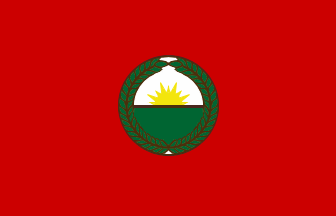 image by Eugene Ipavec, 12 October 2005
image by Eugene Ipavec, 12 October 2005
Standard
Official website of Cuarta División (Fourth Division) at
 www.cuartadivision.mil.co.
www.cuartadivision.mil.co.
E.R., 8 June 2006
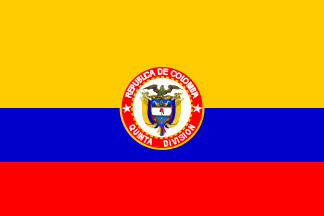 image by Eugene Ipavec, 6 January 2006
image by Eugene Ipavec, 6 January 2006
War Flag
 image by Eugene Ipavec, 12 October 2005
image by Eugene Ipavec, 12 October 2005
Standard
Official website of Quinta División (Fifth Division) at
www.quintadivision.mil.co.
E.R., 8 June 2006
 image by Eugene Ipavec, 6 January 2006
image by Eugene Ipavec, 6 January 2006
War Flag
 image by Eugene Ipavec, 12 October 2005
image by Eugene Ipavec, 12 October 2005
Standard
Official website of Sexta División (Sixth Division) at
www.sextadivision.mil.co.
E.R., 8 June 2006
 image by Eugene Ipavec, 6 January 2006
image by Eugene Ipavec, 6 January 2006
War Flag
 image by Eugene Ipavec, 8 June 2006
image by Eugene Ipavec, 8 June 2006
Standard
Official website of Séptima División (Seventh Division- HQ
in Medellin, Department of Antioquia) at www.septimadivision.mil.co.
E.R., 12 October 2005 and 8 June 2006
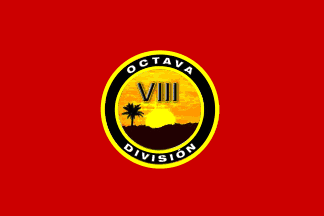 image by Zoltan Horvath, 12 April 2011
image by Zoltan Horvath, 12 April 2011
Official website of Octava División (Eight Division- HQ in Yopal, Department
of Casanare) at www.octavadivision.mil.co.
Flag follows the same pattern as all other Army Division flags, being a red
horizontal flag with the coat of arms in the middle.
Esteban Rivera, 12 April 2011
The War flag is the Colombian tricolor, with the coat of arms in the middle,
with the inscription REPÚBLICA DE COLOMBIA on the top, and OCTAVA DIVISIÓN on
the bottom. The Standard is the Army's red background horizontal flag with the
Division's coat of arms in the middle.
Esteban Rivera, 22 May 2011
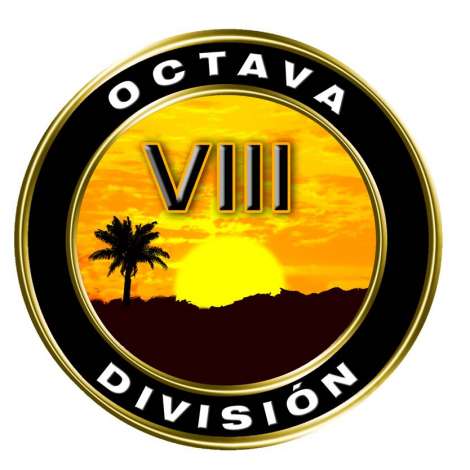 image located by
Esteban Rivera, 11 April 2011
image located by
Esteban Rivera, 11 April 2011
Image of Army's 8th Division coat of arms taken from its official website
Source:
http://www.cemil.mil.co/tools/microsThumb.php?src=recursos_user/imagenes//cemil/CEMIL/div08.jpg&w=470
 image by Eugene Ipavec, 2 March 2006
image by Eugene Ipavec, 2 March 2006
All the additional official flags have the same plain
background.
E.R., 2 March 2006
 image by Eugene Ipavec, 9 August 2005
image by Eugene Ipavec, 9 August 2005
obverse
 image by Eugene Ipavec, 2 March 2006
image by Eugene Ipavec, 2 March 2006
reverse
The flag of the Decimotercera Brigada (Thirteenth Brigade)
based on patch of this Army Brigade at Colombian Army's official
website and photo of flag seen during a parade at the
Brigade's HQ in Bogotá at
CAMBIO magazine.
E.R., 9 August 2005
 image by Eugene Ipavec, 2 July 2006
image by Eugene Ipavec, 2 July 2006
The 17th Brigade belongs to the Seventh Division. The official
website of the 17th Brigade is at
www.ejercito.mil.co.
E.R., 2 July 2006
 image by Eugene Ipavec, 6 March 2009
image by Eugene Ipavec, 6 March 2009
The 18th Brigade belongs to the Second Division. Image based
on photo at "El Tiempo". Another Coat of Arm version
can be found at www.ejercito.mil.co.
E.R., 6 March 2009
This flag was spotted on February 24, 2008 during a military
fair. It is the flag of the Grupo de Caballería Mecanizada
No. 4 "Juan del Corral" (Mechanized Cavalry Group No. 4
'Juan del Corral'). It is part of the Cuarta Brigada (Fourth
Brigade), Séptima División (Seventh Division).
The flag is on yellow background symbolizing Mechanized Cavalry
Units and it has the Cavalry Coat of Arms, seen on the
website of the ESCAB (Escuela
de Caballería, Cavalry School).
It is likely that the colors of the Arms (i.e. Cavalry, Infantry,
etc.) of the Army have been taken based upon US Army standards.
E.R., 17 April 2008
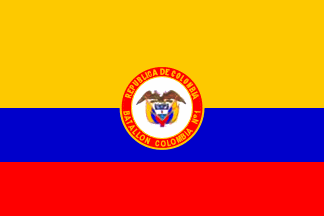 image by Eugene Ipavec, 11 August 2009
image by Eugene Ipavec, 11 August 2009
War Flag - Batallón de Infantería No. 1
"Colombia"
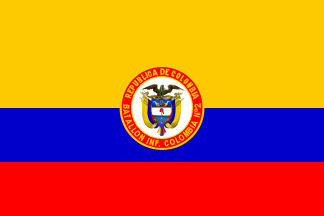 image by Eugene Ipavec, 11 August 2009
image by Eugene Ipavec, 11 August 2009
War Flag - Batallón de Infantería No. 2
"Colombia"
 image by Eugene Ipavec, 3 November 2005
image by Eugene Ipavec, 3 November 2005
Standard - "Batallón de
Infantería Colombia" No. 3
.jpg) image contributed by E.R., 15 June 2005
image contributed by E.R., 15 June 2005
Coat of Arms - "Batallón de
Infantería Colombia" No. 3
The MFO is an indpendent "task force", created after
the Camp David Accords (1978). It is an independent international
organization (non-UN peacekeeping force) and it is made up of
different countries. The Multinational Force & Observers is
responsible for supervising implementation of the security
provisions of the Treaty of Peace between Egypt and Israel.
The "Batallón de Infantería Colombia" No. 3 (Infantry
Battalion No. 3 "Colombia"), abbreviated BICOL, is
attached to the MFO. Official website at bicol3.galeon.com.
Here is a photo of the
pennant of Infantry Battalion No. 3 "Colombia".
E.R., 15 June and 3 November 2005
The flag of the Batallón de Infantería No. 2
"Colombia" is seen here in this
picture
taken on July 20, 2004. Notice that on the bottom fringe it reads
on yellow capital letters: BATALLON INF. COLOMBIA Nº2.
E.R., 10 August 2009
The BICOL , more commonly known as Batallón Colombia
(Colombia Battalion) has had several denominations regarding their
deployments as follows:
Batallón Colombia No. 1 was Deployed during the
Korean War (1950-1953). After the North Korean invasion of South
Korea on June 25th, 1950, the UN Secretary General Trygve Lie
appealed to the member nations for support against this
aggression. Newly elected (not yet in office) Presidential
Candidate Laurean Gómez had already showed his support for the
South Koreans in a public speech on June 30 of this same year.
The Minister of War of that time, Roberto Urdaneta, had offered
military aid by July 28, which became formal on November 14. On
December 26, 1950, by Decree No. 3927, the Batallón de
Infantería No. 1 "Colombia" was established with 1,060
soldiers including the Frigate A.R.C. Almirante Padilla (FG 11),
ex USS Groton (PF-29) of 180 men, which had been sold to Colombia
on March 26, 1947. The Frigate served under U.S. Task Force 95.
Later on, two other Colombian Frigates replaced the A.R.C.
"Almirante Padilla". First was the A.R.C.
"Capitán Tono", ex USS Bisbee (PF-46) acquired by
Colombia through the Mutual Defense Assistance Act commonly known
as the Battle Act. Then the A.R.C. "Almirante
Brión" (FG 14), ex USS Burlington (PF-51), sold to Colombia
on June 26, 1953. The Army and Naval Units served until 1955.
The Batallón Colombia which served under the U.S. Army 7th
Infantry Division, had several relevos (relays or replacements)
so they were called Contingente No. 1, No. 2, etc. (Contingents
No. 1, No. 2, etc.). A total of 4.314 men participated in this
first Batallón Colombia. Many awards and decorations were
awarded to the Battalion as well as to many of its individuals.
Sources:
www.caballerosandantes.net
, www.armada.mil.co
and ascove.org.co.
The Battalion flag is seen here in the following pictures taken
on July 20, 2009:
here,
here
and
here.
The inscription on the lower fringe of the yellow circle
surroundin the Colombian Coat of Arms reads: BATALLON COLOMBIA
N°1.
Batallón Colombia No. 2 - The first United
Nations Emergency Force (UNEF) was established by United Nations
General Assembly to secure an end to the 1956 Suez Crisis with
resolution 1001 (ES-I) on November 7, 1956. The force was
developed in large measure as a result of efforts by UN
Secretary-General Dag Hammarskjöld and a proposal from Canadian
minister of external affairs Lester Pearson. The General Assembly
had approved a plan submitted by the Secretary-General which
envisaged the deployment of UNEF on both sides of the armistice
line. However, the government of Israel refused to permit UNEF to
deploy on their side of the line. After multilateral negotiations
with Egypt, eleven countries offered to contribute to a force on
the Egyptian side of the armistice line: Brazil, Canada,
Colombia, Denmark, Finland, India, Indonesia, Norway, Poland,
Sweden, and Yugoslavia. Support was also provided by United
States, Italy, and Switzerland. The first forces arrived in Cairo
on November 15, and UNEF was at its full force of 6,000 by
February 1957. The force was fully deployed in designated areas
around the canal, in the Sinai and Gaza when Israel withdrew its
last forces from Rafah on March 8, 1957.
The Batallón Colombia No. 2 was part of this mission. UNEF ended
its mission in May 1967
Sources:
Wikipedia.
Batallón Colombia No. 3 In accordance with the Camp David
Accords, and after a petition from the MFO
Commander Lemon R. Hunt, Colombia issued Disposition
No. 00013 of 16 of October, 1981. Then by Decree No. 692 of March
5, 1982 the Batallón Colombia No. 3 is established and it was
made up of 40% Infantry , 20% Cavalry, 20% Artillery and 20%
Engineers. It was sent to the Sinai Peninsula on October 8, 1982
as part of the MFO
Source: www.ejercito.mil.co.
E.R., 11 August 2009
 image by Eugene Ipavec, 12 January 2010
image by Eugene Ipavec, 12 January 2010
Batallón Colombia War Flag - The flag is the Colombian
Tricolor, with the Coat of Arms, and on the top fring it reads
REPUBLICA DE COLOMBIA in bold capital golden letters, and on the
bottom it reads BATALLON COLOMBIA.
You can see an actual picture
of the flag at
Unofficial
Colombian Military Forces website.
E.R., 12 January 2010
Unusual in that the ring is a very dark red; normally on
these flags it is plain red.
Eugene Ipavec, 12 January 2010
There was an article published four days ago on the
Army's
official website showing a ceremony for new replacements into
this Battalion. A
picture
on the article shows a variant of the BICOL Standard Pennant we
show above. The difference in this variant is the number 3, which
corresponds to the actual Battalion stationed there, as displayed
on the War Flag.
E.R., 25 January 2010
 image located by Esteban Rivera, 19 July 2011
image located by Esteban Rivera, 19 July 2011
I found the Pennant for 'Compañía
D' (D Company) of the Batallón Colombia while stationed during
the Korean War (1950-1953)
Image of pennant.
Source:
http://foro.unffmm.com/viewtopic.php?f=40&t=323
Esteban Rivera, 19 July 2011
It looks pretty unmistakably like a signboard nailed to two wooden posts.
Eugene Ipavec, 20 July 2011
See: Batallón Colombia- Rank Flags
See also: Sinai Multinational Force & Observers Flag
 image by Eugene Ipavec, 20 November 2005
image by Eugene Ipavec, 20 November 2005
War Flag
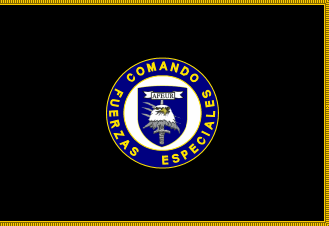 image by Eugene Ipavec, 14 September 2006
image by Eugene Ipavec, 14 September 2006
Standard
 image by Eugene Ipavec, 20 November 2005
image by Eugene Ipavec, 20 November 2005
Pennant
.gif) image by Eugene Ipavec, 14 September 2006
image by Eugene Ipavec, 14 September 2006
coat of arms
The AFEAU (Agrupación de Fuerzas Especiales Antiterroristas
Urbanas, Urban Special Antiterrorist Forces Group) are an elite
force depending directly from the Comando General de las Fuerzas
Militares (General Command of Military
Forces).
The Additional official flag should be the official flag of
Colombia with the same ratio with Coat of Arms, but the
inscription on the upper red fringe of the Coat of Arms reads
"REPUBLICA DE COLOMBIA" and the bottom inscription
should read AFEAU. The image is based on photo from Colombia's
Independence Day, July 20th, 2002. taken from the Ministry of
National Defense official website.
The Pennant is based on photo taken from TV channel Canal A. The
photo is from Colombia's Independence Day, July 20th, 2003.
Homepages of AFEAU at
www.ejercito.mil.co
and
www.cgfm.mil.co.
E.R., 20 November 2005
The difference between the Brigada de Fuerzas Especiales (Special Forces Brigade) and the AFEAU (Urban
Special Antiterrorist Forces Group), is that the Brigade is made
up of Battalions that operate temporarily attached to any given
Army Battalion or Army Brigade, with national jurisdiction, while
the AFEAU units are platoon-sized elements that are permanently
based on the Headquarters of each Army Division, so they only
have operational jurisdiction over the area in which their
Division operates. Now, there are five AFEAU groups even though
there are seven Army Divisions in existence: the Colombian
government is getting the funds and its men trained in order to
create two more AFEAU groups.
Source: www.ejercito.mil.co.
E.R., 25 December 2005
Information on the AFEAU: Fuerzas Especiales Anti-Terroristas
Urbanas (AFEAU)  www.specialoperations.com
- Urban Counterterrorist Special Forces. The national hostage
rescue/counterterrorist unit is the Fuerzas Especiales
Anti-Terroristas Urbanas (AFEAU). It is made up of between 70 and
100 personnel from all branches of the Armed Forces as well as
the National Police and is under the overall command of the
Comandante de las Fuerzas Armadas (Commander of the Armed
Forces). The unit is divided into four 15-man sub-units, one each
from the Colombian Army, Navy, Marine Corps and National. Each
sub-unit is comprised of two officers and 13 enlisted ranks, all
of whom are volunteers. AFEAU is commanded by an Army major who
heads a headquarters section comprised of an executive officer,
first sergeant, communications operator. It was created as a
direct result of the failed assault on the Palace of Justice in
Bogota on November 5 and 6, 1985, which resulted in the deaths of
not only the M-19 terrorists, but
also some 80 soldiers, policemen and hostages as well. In
addition to the assault teams, the AFEAU has dedicated sniper
teams, a crisis management team, and a hostage negotiation
element.
www.specialoperations.com
- Urban Counterterrorist Special Forces. The national hostage
rescue/counterterrorist unit is the Fuerzas Especiales
Anti-Terroristas Urbanas (AFEAU). It is made up of between 70 and
100 personnel from all branches of the Armed Forces as well as
the National Police and is under the overall command of the
Comandante de las Fuerzas Armadas (Commander of the Armed
Forces). The unit is divided into four 15-man sub-units, one each
from the Colombian Army, Navy, Marine Corps and National. Each
sub-unit is comprised of two officers and 13 enlisted ranks, all
of whom are volunteers. AFEAU is commanded by an Army major who
heads a headquarters section comprised of an executive officer,
first sergeant, communications operator. It was created as a
direct result of the failed assault on the Palace of Justice in
Bogota on November 5 and 6, 1985, which resulted in the deaths of
not only the M-19 terrorists, but
also some 80 soldiers, policemen and hostages as well. In
addition to the assault teams, the AFEAU has dedicated sniper
teams, a crisis management team, and a hostage negotiation
element.
Training is carried out primarily at a facility in Facatativa,
north of Bogota. Members are schooled in a wide variety of
disciplines, including close-quarters combat, short and longs
range marksmanship, hand-to-hand combat, and even air assault
operations. Specific hostage rescue skills are developed for the
major transportation scenarios including trains, busses, and a
wide variety of airplanes.
The ring of the coat of arms contains the inscription
"COMANDO FUERZAS ESPECIALES". The acronym spell AFEUR.
Concerning AFEAU v. AFEUR - AFEAU stands for Agrupación de
Fuerzas Antiterroristas Urbanas... and AFEUR stands for
Agrupación de Fuerzas Antiterroristas Urbanas y Rurales.
Both are exactly the same thing: that is, there is no
difference because those are two ways to refer to them (The
emblem and the flag say AFEUR but for example, the pennant reads
AFEAU, and the official website on the internet also says AFEAU).
After several months of research on this subject, I have come to
the conclusion that they are the same thing: however their
uniforms are different when it comes to rural operaions
(bascially army jungle camouflage pattern) and urban operations
(a kind of snow environment camouflage, in different shades of
gray). The gear is the same for all groups and there are AFEAU
Police units and AFEAU military units.
E.R., 14 & 18 September 2006
There's an article on the organization of the AFEAU at
www.cgfm.mil.co.
It says that the AFEAU is composed of five Destacamentos
(Detachments) as follows:
- Alpha (Army)
- Bravo (Navy)
- Charly (Air Force)
- Delta (Police)
- Omega (Expert sharpshooters).
E.R., 18 August 2009
 image by Eugene Ipavec, 11 August 2009
image by Eugene Ipavec, 11 August 2009
Standard
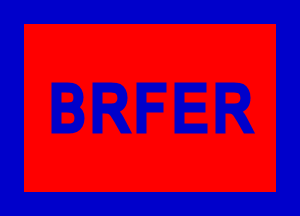 image by Eugene Ipavec, 25 December 2005
image by Eugene Ipavec, 25 December 2005
Square Pennant
 image by Eugene Ipavec, 25 December 2005
image by Eugene Ipavec, 25 December 2005
Triangular Pennant
All Colombian Military Units have an official flag and also an
official pennant (usually having the initials of the unit). This
is the Pennant of this military unit called Brigada de Fuerzas
Especiales, or Special Forces Brigade. It's abbreviation is
BRFER.
It is directly below the General Command
of Military Forces in the structure on the military
organization. The difference between the Brigada de Fuerzas
Especiales (Special Forces Brigade) and the AFEAU
(Urban Special Antiterrorist Forces Group), is that the Brigade
is made up of Battallions that operate temporarily attached to
any given Army Battalion or Army Brigade, with national
jurisdiction, while the AFEAU units are platoon-sized elements
that are permanently based on the Headquarters of each Army
Division, so they only have operational jurisdiction over the
area in which their Division operates. Now, there are five AFEAU
groups even though there are seven Army Divisions in existence:
the Colombian government is getting the funds and its men trained
in order to create two more AFEAU groups.
Source: www.ejercito.mil.co.
E.R., 25 December 2005
The BRFER flag is seen displayed
here.
It is the red color Army flag with the Coat of Arms on the middle
on a dark blue background. Below it reads COMANDO. This Coat of
Arms is based on the badge of the graduates of the Special Forces School. The flag on
the picture actually has the old logo of the Contraguerrilla
Commando (Counter guerrilla commando) insignia which is featured
on this paramilitary flag. The
counter guerrilla insignia representing an eagle catching a snake
was taken without permission by the paramilitary group, in fact
many paramilitary members wear green T-shirts underneath their
camouflage uniforms, and those T-shirts have the eagle as logo.
The new logo is here.
E.R., 10 August 2009
On March 24, 2011 I found some information on the Batallón Guardia
Presidencial (Presidential Guard Battalion) flag.
The current Battalion is officially called Batallón de Infantería No. 37
'Guardia Presidencial' (Infantry Battalion No. 37 "Presidential Guard"), and it
was established on December 7, 1927 by President Miguel Abadí Méndez. Later on,
by Decree No. 367 of 1928 is named "Batallón Guardia Presidencial". It has its
origins in the Guardia de Honor (Honor Guard) established by General Simón
Bolívar in 1814.
The Battalion is under the command of the Army's 13th Brigade,
5th Division and has the following Companies:
- Compañía de Infantería (Infantry Company), known as Córdova Company
- Compañía de Caballería (Cavalry Company), known as Rondón's Company
- Compañía de Artillería (Artillery Company), known as Ricaurte's Company
- Compañía de Ingenieros (Engineers Company), known as Caldas Company
- Pelotón de Soldados de la Casa Militar (MIlitary House Platoon), known as
Fergusson's Company.
Source:
http://es.wikipedia.org/wiki/Casa_de_Nari%C3%B1o#Defensa
The Battalion's flag is a horizontal flag, green (25%) /white (50%) /green
(25%), with the coat of arms in the middle. The coat of arms has a roundel in the middle with the
inscription "BATALLÓN GUARDIA", on top in bold capital black letters, and
"PRESIDENCIAL" on the bottom in bold capital black letters.
Images:
Battalions' flag, first version, with the
coat of arms having a red background.
Source:
http://www.facebook.com/group.php?gid=5187328501#!/photo.php?fbid=438403995100&set=o.5187328501&theater
Battalions' flag, second version, with
the coat of arms having a white background
Sources:
http://www.facebook.com/group.php?gid=5187328501#!/photo.php?fbid=10150096361141894&set=o.5187328501&theater,
Image of coat of arms:
http://www.facebook.com/group.php?gid=5187328501#!/photo.php?fbid=10150096361136894&set=o.5187328501&theater
Source:
http://www.facebook.com/group.php?gid=5187328501#!/photo.php?fbid=450197609137&set=o.5187328501&theater
(Another version of the coat of arms is found
here)
Additional sources:
-
http://www.terra.com.co/actualidad/galerias/gal54400.htm (Picture
gallery of the 80th anniversary o the Battalion)
-
http://www.youtube.com/watch?v=1Russ8j8AjY (video showing the
Battalion's flag (from 0:14 until 0:18 and 1:37 until 1:44
-
http://wsp.presidencia.gov.co/CasaNarino/Paginas/CasadeNarino3.aspx
(Picture)
-
http://wsp.presidencia.gov.co/CasaNarino/Paginas/CasadeNarino6.aspx
(Picture)
-
http://wsp.presidencia.gov.co/CasaNarino/Paginas/CasadeNarino7.aspx
(Picture)
Semi official page of the Batallón No. 37 Guardia Presidencial:
http://www.ejercito.mil.co/?idcategoria=277533
Esteban Rivera, 22 May 2011
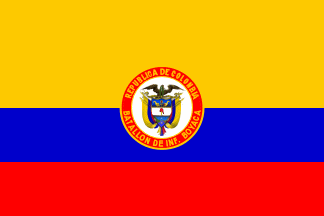 image by Eugene Ipavec, 12 August 2009
image by Eugene Ipavec, 12 August 2009
During the Colombo-Peruvian War of 1932-1933, some Army
Battalions as well as Naval and Air Force Units participated in
combat actions against the Peruvians.
One of these Units is the Batallón de Infantería Boyacá
(Boyaca Infantry Battalion). Its War Flag can be seen
here
(picture taken on July 20, 2009).
E.R., 10 August 2009
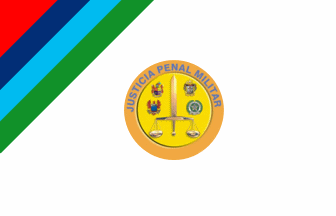 image by Eugene Ipavec, 3 October 2005
image by Eugene Ipavec, 3 October 2005
obverse
 image by Eugene Ipavec, 8 March 2006
image by Eugene Ipavec, 8 March 2006
reverse
Flag description from the
official
website (translated from Spanish):
"The flag of the Criminal Military Justice (Justicia Penal
Militar) has a white background and four stripes, from top to
bottom red, dark blue, light blue and green. On the center a
circled Coat of Arms, on dark yellow background, bearing a sword
with the tip facing upwards, superimposed on the balance of
justice, both with golden ends, with the Coats of Arms of the
Army, Navy, Air Force and National Police [hence the colors
mentioned before], and with the motto around reading 'CRIMINAL
MILITARY JUSTICE' written in black letters.
Coat of Arms (translated
from Spanish):
"White represents transparency, trust, honesty; the colors
red, dark blue, light blue and green, as well as their
corresponding Coats of Arms, represent each one of the Forces in
which the Criminal Military Justice serves which are: National
Army, Navy, Air Force, an National Police; the yellow and gold
colors stand for commitment and wisdom. The balance featured on
the flag is the universal symbol of justice".
E.R., 27 June 2005
Hosted by: Fanshop-Online.de und Handy-Shop.de
Tipp: Apple iPhone 12 im Shop